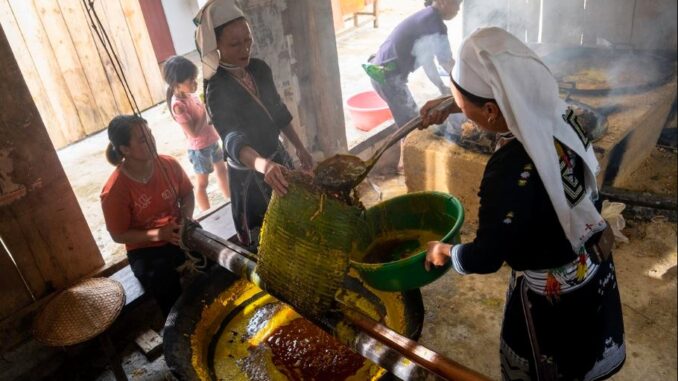
The Dao Tien people protect the happy bees, do not take honey but wait until the autumn when they fly away to get beeswax to print patterns on the fabric.

In early August 2021, Ha Kim Cuong, Vu Khac Chung and Nguyen Son Tung share the same passion for experiential photography, promoting tourist destinations in Cao Bang, having a field trip with the Dao Tien people to harvest honeycomb wax. enjoy.
These giant honeycomb nests cling to high cliffs in Hoai Khao village, Quang Thanh commune, about 20 km from Nguyen Binh town, Nguyen Binh district, about 20 km and about 60 km from Cao Bang city. To harvest, people climb on homemade ladders tied to a large tree near the wall and use bamboo poles with flat wooden bars to poke and cut the beehives.

In the spring, bees like to fly back to gather to make about 60-80 nests, in the early fall they fly away and leave behind beeswax. The honeycomb wax pieces are about 1m in diameter.

Mr. Vu Khac Chung was impressed with the golden color of the honeycomb wax. Although living in Cao Bang, this is the first time he has had the opportunity to experience harvesting beehives, a valuable source of raw materials, which can be boiled into beeswax to print on fabrics, creating unique patterns on the costumes of the Dao. Money.

This honeycomb area is protected by Hoai Khao people. They do not take honey and do not allow outsiders to exploit it. When the bees migrate, the whole village will harvest the nests. This both helps to preserve the bees, and has wax as an annual traditional costume, “the relationship between the bees and the people of Hoai Khao” has existed for nearly 200 years.

According to Mr. Ha Kim Cuong, owner of Cao Bang Hong fanpage , the process of harvesting beeswax is done by the whole neighborhood together, each person undertakes a separate job such as collecting firewood, cooking rice, making chicken for offerings and the group goes to poke. take beeswax.

In the early morning, people gathered at the cultural house to urgently work and prepare the offering tray for the magician to bring to the ceremony. The offerings usually include boiled chicken, wine, incense and votive coins. Worshiping ceremony to choose a good day, pray for all the good things, and a bountiful beeswax season.

The honeycomb wax that you bring home is separated, broken into small pieces and put in a large cast-iron pan to boil with water.

People cook while stirring the honeycomb wax pan. When the water boils, the pure beeswax gradually dissolves into the water, but there is still wax left in the honeycomb seams.

The next stage is to pick up the honeycomb seams and put them in a bamboo basket and then clamp them to force the beeswax juice to flow into the pan, the raw beeswax is removed.

After pressing the beeswax juice into the pan, pour cold water into the pan, the beeswax meets the cold water and crystallizes, forming a golden seam floating on the water.

These golden beeswax seams are again picked up, washed, removed impurities and put in a condensing pan, forming pure, concentrated beeswax that can be preserved and used for many years. The process of heating and cooking beeswax requires techniques so that the finished wax has a thin, soft and smooth consistency so that when printing on fabric, it has enough adhesion on the fabric.

All Dao Tien women are proficient in the technique of printing geometric patterns, plants, flowers, birds, animals with beeswax on fabrics to create elaborate costumes. In addition to indigo clothes, people also wear silver jewelry such as silver buttons for accents. These unique traditional cultural features are preserved and preserved, helping Hoai Khao have favorable conditions to develop community-based tourism in an effective and sustainable direction. Follow vnexpress
Photo: Ha Cuong, Khac Chung, Son Tung
